Last year we did two pairings, Japan’s Food & Sake Pairing (here) and Morocco’s Food & Wine Pairing (here). We enjoyed the event in Japan quite a lot, so we’re repeating it this year; and luckily for us, they’ve changed the menu and the presentation a bit. This was our second of three such pairings for 2011 (Mexico’s Tequila Lunch, this event, and Italy’s Beer & Pizza Pairing (next week)).
As usual, we arrived early and nick was able to snap a few photos of the place settings for the event; the table scape was more elaborate and festive than last year.
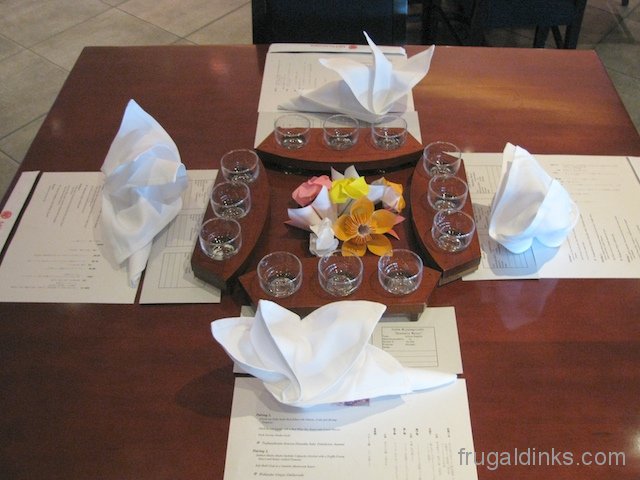
The tables are ready for the guests
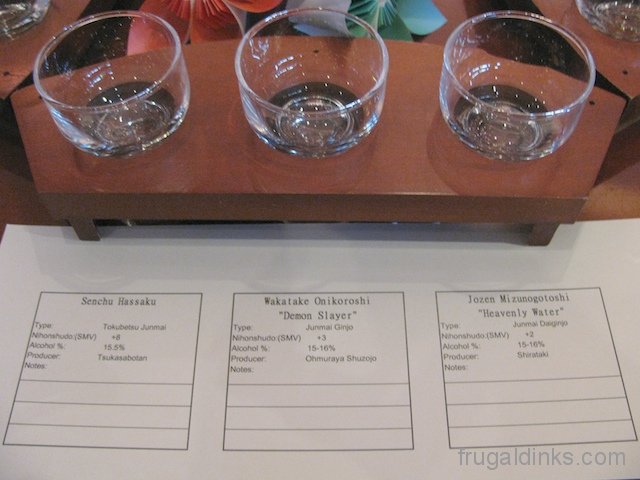
We were served three sakes during the course of the pairing
Our host was Scott Farrow, manager of Mitsukoshi restaurants at the Japan Pavilion at Epcot. Our co-host was Chef Noriko. There were also two sous-chefs and numerous table attendants, our particular attendant was named Asami. They are all very courteous and cheerful. We’ve noticed that at Tokyo Dining, all of the chefs and all of the servers are female. What we didn’t know before was that the sushi chefs are not traditionally trained sushi chefs (having known numerous sushi chefs, it’s traditional that training takes YEARS and that a trainee often labors at menial tasks for a long time before even being allowed to prep fish, much less create sushi), these women get their sushi training at Tokyo Dining after they arrive at Epcot; it must be an abbreviated training because they’re often in the U.S. for less than 18 months. None of this is to say that the sushi here isn’t enjoyable! Because it certainly is.

Our hosts and the staff
The motto of the Mitsukoshi restaurants is “Harmony”, they want to provide hospitality in a caring harmonious environment. They certainly do a good job of it, especially when you consider that they’re located smack dab in the middle of Epcot. At times, these restaurants can be very noisy and a bit chaotic – the only thing that we can think of that they could have done during the 2007 remodel to help with this – more sound baffling and sound deadening materials throughout the venue.
We were seated at a table for four and were soon joined by Monica and Ray from New Jersey. This was their first trip to the Food & Wine Festival sans children, their youngest started college this fall… it was also their first special event for their week long trip.
We have other posts that go into greater detail re: sake history and sake making (here and here). In brief…
- the essential ingredients and their combination that makes sake have been around for 2000 years (this doesn’t mean that sake as we know it today has been around that long)
- never pour sake for yourself, you always pour sake for someone else
- sake is brewed, thus it’s more like beer than like wine
- steamed rice doesn’t contain enough sugar to produce alcohol, so koji rice (that’s rice with koji growing on it) is added for the sugars
- sake and beer are brewed in multistep processes, wine is fermented in more of a single step process
- sake rice, while highly sought after, isn’t rice that you’d eat
- with sake “you get what you pay for”
- unlike with wine, where there are many flavor and aroma profiles readily identifiable (remember “vulcanized rubber“?) – with sake, you look for aromas and flavors that aren’t in OTHER sakes
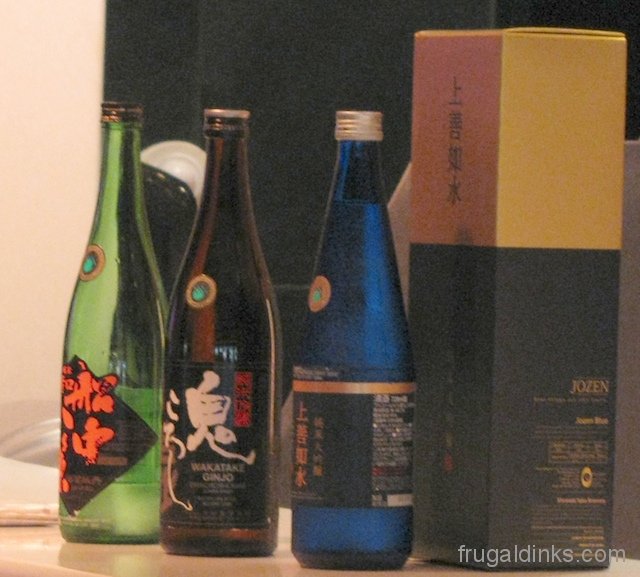
Three sakes for today - Senchu Hassaku, Wakatake Onikoroshi "Dragon Slayer", and Jozen Mizunogotoshi "Heavenly Water"
Chef Noriko instructed us on the order of each pairing and what foods went which which sauces. The pairings were designed to be a complementary experience. Each pairing had at least one traditional Japanese food and at least one food that was a fusion of Japanese and other culture(s). The experience was definitely enhanced by her patient instruction.
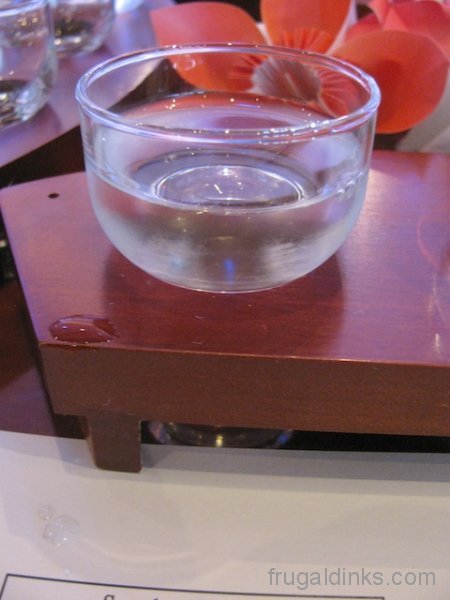
A sake pour - the attendants were very courteous, if our sake glasses were low they would refill them for us
Pairing 1
Sake – Tsukasabotan Sencyu Hassaku Sake Tokubetsu Junmai
- without food – the aroma is very clean and crisp, not a lot of fruit or other scents; the flavor is also very clean and crisp, there isn’t much distinction there
- with food – the sake flavors and aromas are enhanced, you actually taste MORE in the sake

Food for the first pairing - on the left, Green Tea Soba Sushi Roll; on the right, Duck Breast; and in the center, Pork Terrine
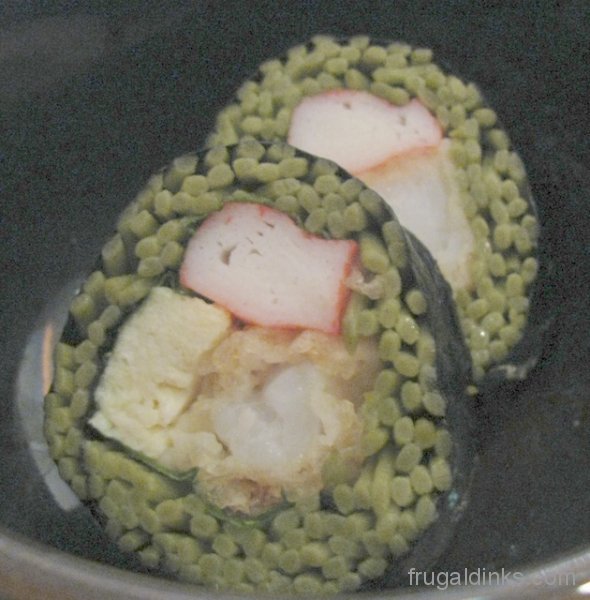
Green Tea Soba Sushi Roll filled with Omelet, Crab, and Tempura Shrimp
Our first tasting was the fusion sushi roll. This was nick’s first choice as far as the pairing with the sake went, however, he didn’t really like the texture of the roll. Nora’s opinion was that it went well with the sake, but doubtful that she’d order it herself.
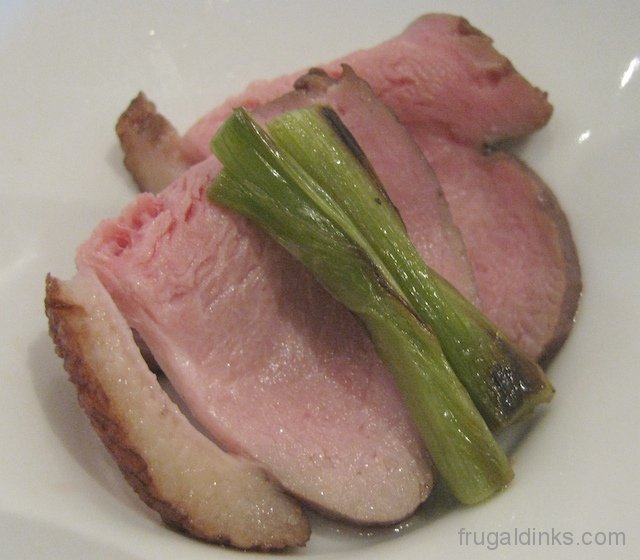
Duck Breast Laced with a Red Wine Soy Sauce and Grilled Green Onions
This was our second tasting during this pairing, the duck breast was served rare with a slight sear on the outside. We both really liked the flavors of this dish, so did our table mates. The flavors were very “meaty” (for lack of a better descriptor), the duck breast was tender and flavorful. While it didn’t seem to complement the sake as much as the soba sushi roll did, the pairing was “off”.
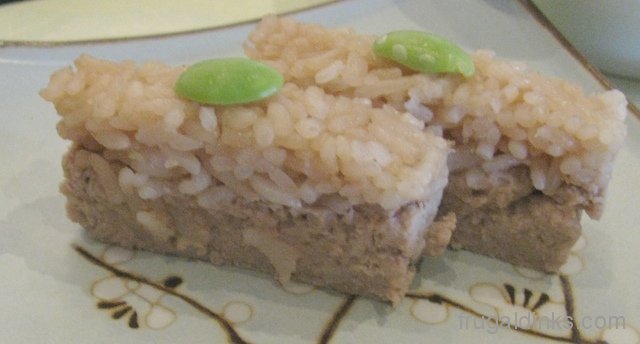
Pork Terrine Osaka Sushi
Our third tasting for the first pairing was a pork terrine. Chef Noriko showed us a box that is used to make pressed sushi (she called it “box style sushi”), this is still sushi although we’re more accustomed to seeing rolled sushi. The bottom layer is a coarse chicken liver pate, then there is a middle layer of ground pork, and the top layer is rice with duck sauce (at first nora thought it was simply brown rice), topped with an edamame. Nora preferred this dish, both alone and with the sake. Nick liked it best by itself, a bit surprising because he doesn’t typically like pate.
Pairing 2
sake – Wakatake Ginjyo Onikoroshi
- without food – aroma is a bit fruitier; flavor is very smooth, fruity, and full (our table mates really liked it)
- with food – sake became sweeter after the salmon and spicier after the tomato; both nick and Monica really liked how the sake paired with the soft shell crab dish
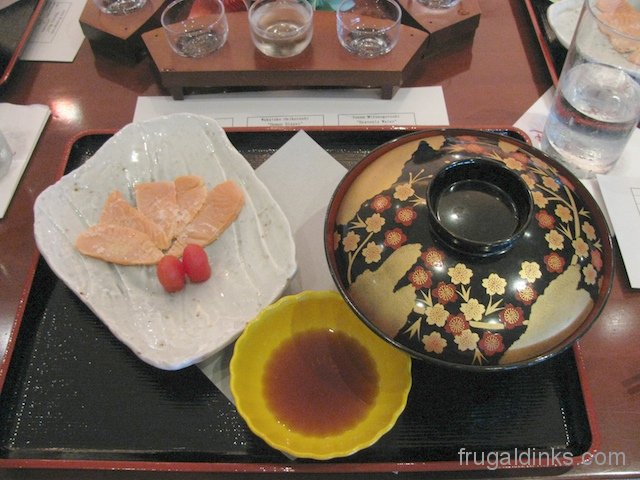
Food for the second pairing - on the left, Salmon Shabu Shabu; and on the right (covered) Soft Shell Crab
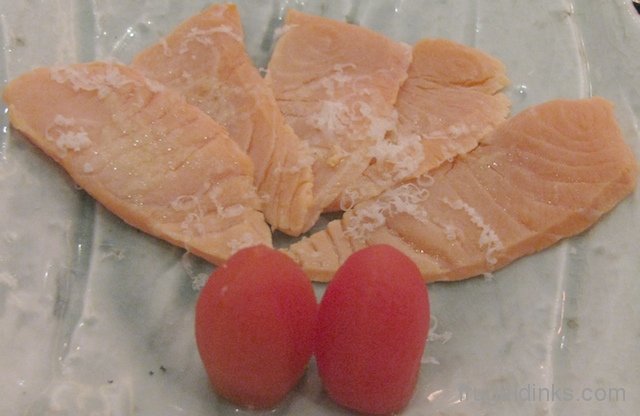
Salmon Shabu Shabu Sashimi Calpacho drizzled with a Truffle Ponzu Sauce and honey soaked Tomatoes
Chef Noriko explained that to eat the shabu shabu, we swish the salmon through the sauce. Shabu shabu gets its name from the sound that foods make when you swish them through a shabu shabu pot (the food swishing sounds like “shhhha boo shhha boo”). You could taste the citrusy ponzu otherwise this salmon was just busting out with umami, maybe too much umami. This dish is another fusion, this time of Japanese and Italian cuisines. The truffle oil was a bit much as was the parmesan cheese – it wasn’t bad, but just wasn’t as pleasing to our palates as the traditional dish was. The honeyed tomatoes were a very nice surprise, our table mates really enjoyed these. Chef explained that they were very simple to make, simply quick blanch grape tomatoes and peel, soak in honey plus water plus a little salt.
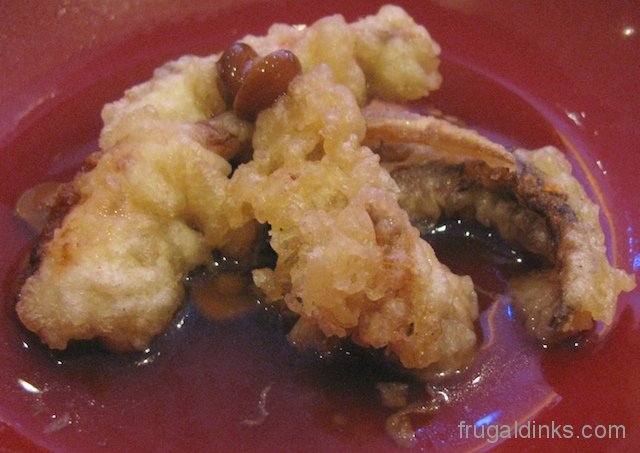
Soft Shell Crab in a Nameko Mushroom Sauce
The soft shell crab was a hit at our table. We already knew that we loved soft shell crab and this traditional preparation was very, very good. Both nick and Monica thought that this paired wonderfully with the sake. The teeny mushrooms were more flavorful than their size would lead you to expect.
Pairing 3
sake – Junmai Daiginjyo Jozen Mizuno Gotoshi
- without food – some comments from our table – very light, can barely taste anything on first sip, very subtle, on second tasting there’s more texture and Ray said that it was “naughty” because it was so good; nick detects some slightly green banana or melon
- with food – we all enjoyed it most with the beef, the citrusy pepperiness in the beef sauce went wonderfully with the sake
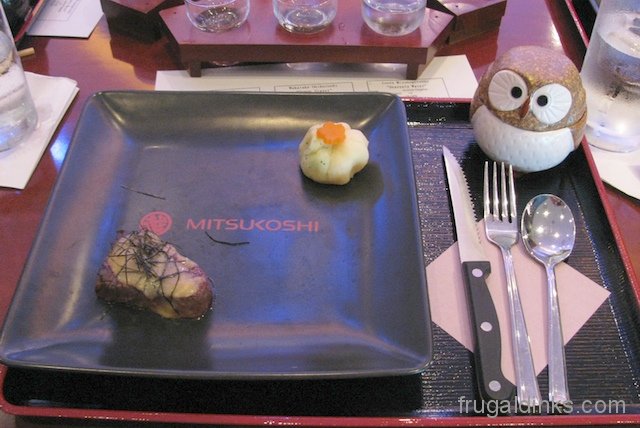
Beef Tenderloin and mashed potato, and inside the little owl, Lobster Bisque
First tasting was the beef. Nick’s comment “rarely eat beef, but wowsa!” This was very very good. After the presentations, Chef Shige (remember him from last week?) came around, the beef was his dish, he was very interested in our impressions and thoughts. This was just the right size and was very delicious, the meat was warm and rare, just perfect.
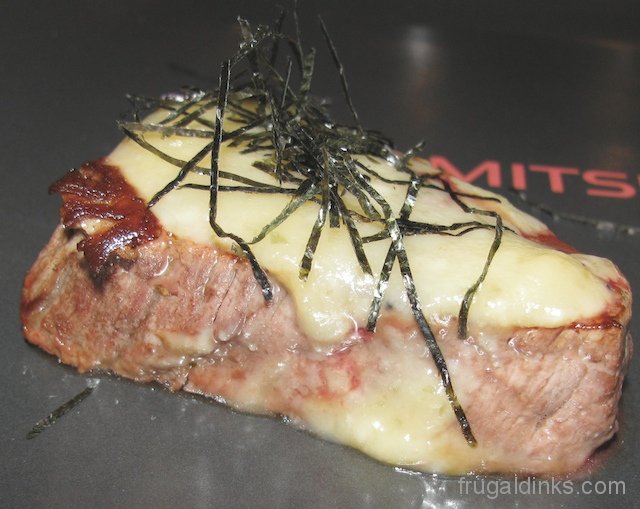
American Wagyu Beef Tenderloin finished with Yuzu-pepper miso sauce and Slivered Nori
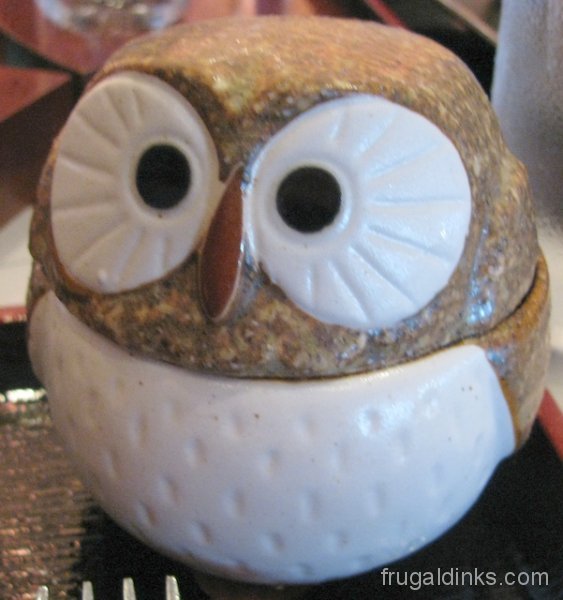
The owl has your bisque
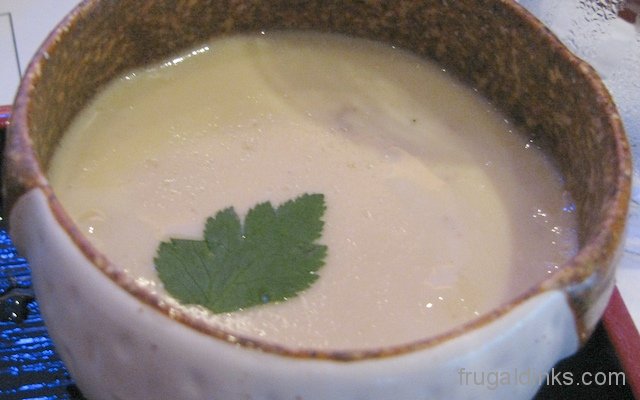
Lobster Milk Consomme Chawan-mushi Style with Carrots, Potato and Mitsuba
The second tasting – we didn’t care for this at all. It was almost like a warm gelatin or mousse with bits of tough lobster in it. Neither of us ate more than 2 or 3 bites. Our table mates enjoyed it and thought it very tasty.
We were served a dessert, by this time the restaurant staff were coming around asking for feedback and our impressions – also, making sure that we had really enjoyed ourselves, so no photo… imagine a martini glass with a pale frozen strawberry cocktail. This would have been “Strawberry Ama Sake Mist” – light and tasty, a good way to end the meal.
Other Information & Wrapping it all up
We haven’t seen other reviews of this particular event online yet. We would definitely do this again in 2012. The service was excellent, the food quality was great, the pairings were nice and with so much food to eat they gave us extra sake!
However, much like last year, the noise level as the event went on became more and more uncomfortable. Keep in mind that this takes place in the sushi bar area of Tokyo Dining, so… you’re very close to the hostess stand where guests enter for both Tokyo Dining and Teppan Edo and where the guests sit and wait for their tables. You’re also next to the Tokyo Dining seating area… both venues are open for lunch/dinner during the event and it can be LOUD. Not only that, the hosts were miked at such a level that it seemed too “high” for the venue; there were lots of spikes in the sound. – of course, we said all of these things after last year’s event –
The Big Questions
- Was the experience worth the price? – Yes, lots of sake, lots of food, and lots of learning.
- Did we feel rushed or hurried? – No, the service was wonderful and we especially liked it when the cooking staff came out to say “thank you” for coming and to solicit our impressions
- Was it weird to sit with strangers? – N0, you can’t stay strangers for long when the sake is flowing
- Did we learn a lot? – Somewhat. We learned more about the food than about the sake (perhaps because we’ve been to numerous sake “classes”) – that said, it would be very nice if some of the sake information was available as a handout either on the tables or as an option when leaving… same for the food
- Was the food adequate for the alcohol served? – Yes, we left feeling full, in fact, we didn’t eat again that day
- Final Thoughts – We really enjoyed this for the second year in a row, and we hope to attend again next year (maybe Al & Judy or Kate & Calvin will join us next year, of course, any of our other friends are welcome to try it with us if they’d like!) It was very nice that the foods changed from last year. And we can’t say enough how impressed we were with the service and staff at the Mitsukoshi Restaurants